May 19, 2025 | 04:56 GMT +7
May 19, 2025 | 04:56 GMT +7
Hotline: 0913.378.918
May 19, 2025 | 04:56 GMT +7
Hotline: 0913.378.918
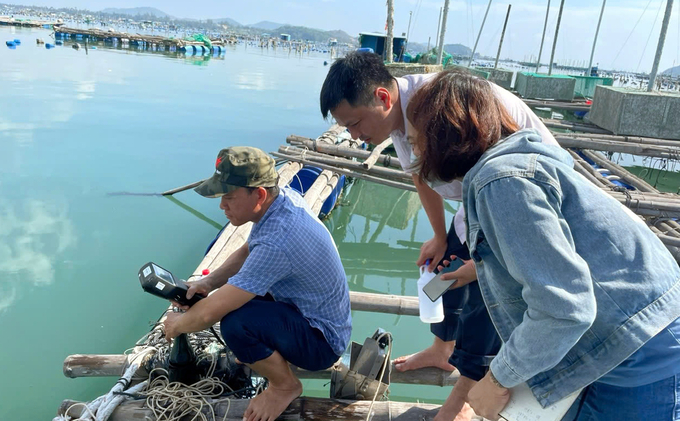
The staff at the Central Region Center for Aquatic Environment Monitoring and Disease Control conducting environmental monitoring at a lobster farming area in the South Central region. Photo: KS.
We recently visited the Central Region Center for Aquatic Environment Monitoring and Disease Control in Nha Trang City (Khanh Hoa Province). During our visit, the staff at the center were urgently finalizing reports on the monitoring and assessment of the water quality in several aquaculture areas in the South Central and Central Highlands provinces.
According to Vo Thi Ngoc Tram, Deputy Director of the Central Region Center for Aquatic Environment Monitoring and Disease Control, climate change is developing in an unpredictable manner, with abnormal weather patterns affecting the health of aquaculture species. Additionally, aquaculture activities currently face frequent risks of dangerous disease outbreaks that can result in significant losses for farmers. Consequently, monitoring and supervising the aquatic environment to issue warnings is a crucial task.
As an institution under the Research Institute for Aquaculture 3 (RIA3), the Center's primary responsibilities include environmental monitoring and warnings, research on aquatic diseases, and providing consultation and technology transfer in monitoring, warning, pathology, and health issues for aquaculture species. The Directorate of Fisheries recently tasked the Institute with conducting environmental monitoring, warnings, and supervision in key aquaculture areas within the South Central and Central Highlands provinces. Accordingly, the targeted regions include Binh Dinh, Phu Yen, Khanh Hoa, Ninh Thuan, Binh Thuan, and Lam Dong.
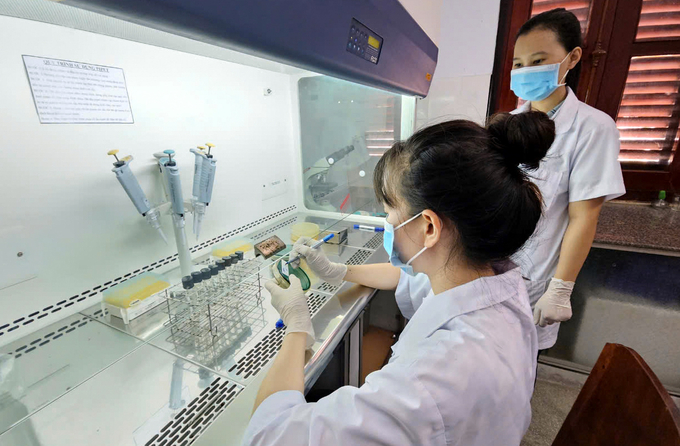
The Center's environmental monitoring and warning operations have become routine. Notably, the center can provide a timely feedback within 3 to 5 days of sample collection. Photo: KS.
The Center's monitoring efforts focus on several key aquaculture species, such as brackish-water shrimp, lobster, and cold-water fish. In addition to environmental monitoring, the Center collects samples to identify agents responsible for dangerous diseases in the monitored species, with the final goal of comparing and assessing the relationship between environmental factors and disease outbreaks. For instance, the Center collects samples to identify the causes of milk disease and red body disease in farmed lobsters from Phu Yen and Khanh Hoa provinces; to detect agents of microsporidiosis, white spot disease, and acute hepatopancreatic necrosis in brackish-water shrimp from Binh Dinh Province; and to identify the cause of hemorrhagic disease in cold-water fish (sturgeon and rainbow trout) from Lam Dong Province.
"The Center's human resources, infrastructure, and equipment are currently up to standard. The environmental monitoring and warning processes have become routine. Notably, the center can provide a timely feedback within 3 to 5 days of sample collection," emphasized Vo Thi Ngoc Tram, Deputy Director of the Center.
At present, the Institute sends monitoring results to the local Departments of Agriculture and Rural Development, Sub-Departments of Fisheries, and district-level Agricultural Departments in monitored areas. Results are shared via Zalo, email, and express mail (EMS). Subsequently, local authorities disseminate the monitoring reports and implement measures to stabilize the environment, thereby promoting effective and sustainable aquaculture development.
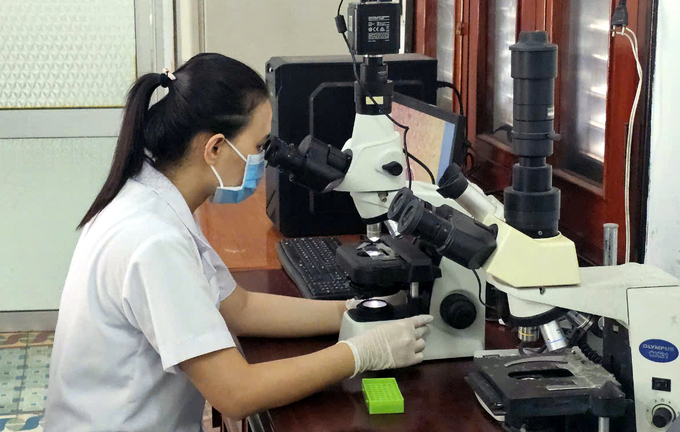
The staff at the Center are well-equipped to carry out environmental monitoring tasks. Photo: KS.
If environmental parameters are found to exceed permissible limits or disease indicators are detected in sampled species during the monitoring process, the Institute assigns staff to directly call relevant parties and inform them of the results. This timely communication helps local authorities and farmers (with collected samples) to assess water quality and the health of their aquaculture species, thereby enabling immediate response measures.
Monitoring data is updated into the Directorate of Fisheries' environmental monitoring database software after each monitoring round. This system facilitates tracking, reference, and supports management, planning, aquaculture development, and traceability requirements for foreign food safety inspection teams.
Tran Van Tu, a caged lobster farmer in Xuan Yen Ward, Song Cau Town, Phu Yen Province, believes that in addition to technical experience, staying informed regarding environmental monitoring and disease outbreaks in water sources is crucial in aquaculture. According to him, local lobster farmers have regularly followed environmental information provided by relevant authorities to proactively prevent aquatic diseases and minimize losses.
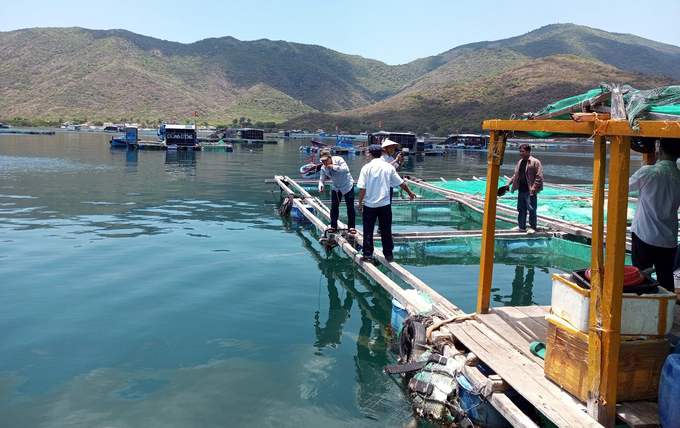
Through the monitoring, warning, and surveillance of the aquaculture environment, farmers in the South Central provinces have proactively prevented aquatic diseases and minimized losses. Photo: KS.
Le Thi Hang Nga, Deputy Director of the Phu Yen Province's Sub-Department of Fisheries, reported that Phu Yen is a coastal province with strong potential for aquaculture, focusing on a variety of aquatic species such as giant tiger prawn, whiteleg shrimp, lobster, and marine fish.
With the aim of minimizing losses for aquaculture farmers, Phu Yen Province's Department of Agriculture and Rural Development recently collaborated with the Research Institute for Aquaculture 3 to conduct environmental monitoring in caged lobster farming areas within Xuan Phuong Commune and Xuan Thanh and Xuan Yen Wards (Song Cau Town). Additionally, the province also conducted monitoring in brackish-water shrimp breeding and production areas in Hoa Hiep Nam Commune (Dong Hoa Town) and Xuan Hai and Xuan Hoa Communes (Song Cau Town).
Subsequently, the Institute promptly communicates the monitoring results to local management agencies to support the management and organization of aquaculture production activities. This initiative also enables farmers in the province to actively monitor changes in water quality and effectively prevent disease outbreaks.
"The recent implementation of environmental monitoring and disease surveillance programs and plans by the Ministry of Agriculture and Rural Development, conducted by the Research Institute for Aquaculture 3, has allowed farmers in Phu Yen to proactively prevent aquatic diseases and minimize losses. Additionally, this initiative has provided local fisheries management agencies with additional data and scientific basis to effectively organize aquaculture activities and promptly respond to irregular weather events such as heat waves and floods," Deputy Director Nga shared.
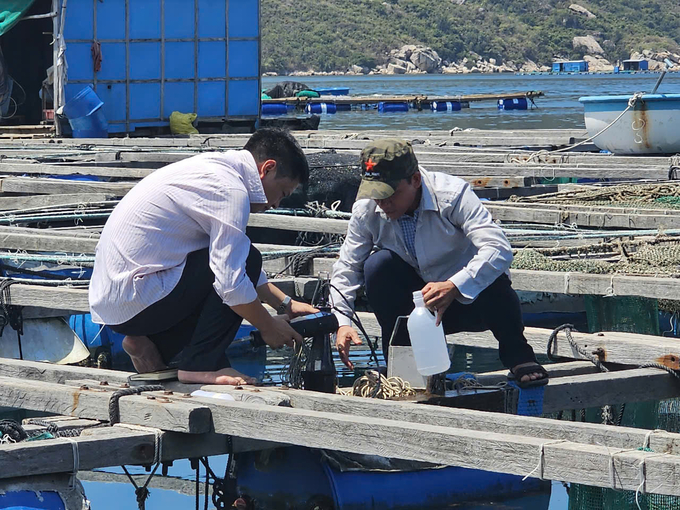
The staff at the Center collecting water samples and measuring environmental parameters at the lobster farming area in Van Ninh District, Khanh Hoa Province. Photo: KS.
In response to the recent increase in abnormal mass mortality of lobsters and aquaculture species in several farming areas, the Phu Yen Province's Department of Agriculture and Rural Development has promptly coordinated with the Institute and environmental monitoring agencies to conduct unscheduled environmental assessments. These assessments aim to identify the causes of the deaths and propose solutions to manage production and minimize losses for farmers. Most recently, the sudden deaths of grouper and farmed lobsters in Cu Mong Lagoon, located in Xuan Canh and Xuan Thinh communes (Song Cau Town) during May and June 2024, were promptly monitored and sampled by the Institute.
Phan Ngoc Tan, Deputy Director of the Khanh Hoa Province's Sub-Department of Fisheries, highlighted that environmental monitoring is a crucial activity in the government's management of environmental protection. Accordingly, the monitoring and environmental warning process must be conducted in a regular, continuous, and systematic manner to detect factors that may negatively impact aquaculture environments. Moreover, the process enables management agencies to issue alerts and guide farmers in implementing necessary remedial measures.
The implementation of environmental monitoring in aquaculture in Khanh Hoa Province since 2016 has facilitated the monitoring of water quality under increasingly unfavorable weather conditions for aquaculture species, thereby increasing farmers' control over the health of their farmed animals. This proactive approach allows management agencies to effectively organize production efforts and minimize disease outbreaks, contributing to the sustainable development of the province's aquaculture sector.
According to Deputy Director Phan Ngoc Tan, the Research Institute for Aquaculture 3 also conducts monitoring at sites not covered by the Sub-Department's monitoring station on a yearly basis. After analyzing the environmental parameters, the Institute delivers results to state management agencies, such as the Department of Agriculture and Rural Development, Sub-Department of Fisheries, Economic/Agricultural Offices, or other relevant local agencies. This approach ensures that farmers receive technical recommendations aimed at enhancing the effectiveness of aquaculture while also providing management agencies with timely information for organizing production activities.
Translated by Nguyen Hai Long

(VAN) 14 out of 35 domesticated elephants in Dak Lak province have had their living conditions improved, with 11 of them currently participating in the non-riding elephant tourism model.

(VAN) Muong Nhe Nature Reserve hopes that being upgraded to a national park will lay the foundation for forest protection efforts to be carried out in a systematic, modern, and sustainable manner.
/2025/05/16/3923-2-171845_52.jpg)
(VAN) Lower costs, higher yields, and improved soil quality are outstanding benefits that soybeans bring when integrated into the crop rotation system.
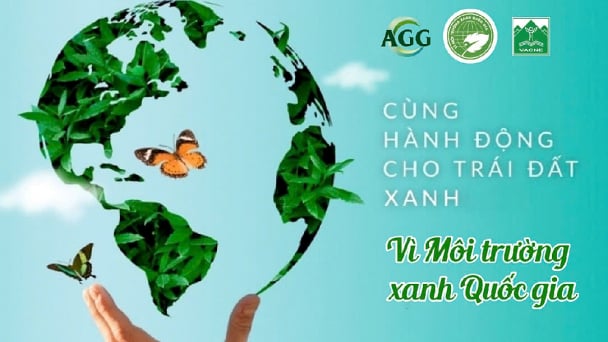
(VAN) The 'For a Green National Environment' programme aims to promote a green lifestyle, support businesses in implementing ESG practices, and turn Net Zero commitments into concrete actions.

(VAN) Cold-barn systems efficiently manage environmental and temperature conditions, which aids in the prevention of respiratory diseases in pigs and protects them from the vectors that transmit African swine fevers.

(VAN) To tackle challenges, the project 'Addressing key technical bottlenecks in the grouper supply chain in Vietnam' has been underway since 2024.

(VAN) The project 'Disease-Resilient and Sustainable Cassava Production Systems in the Mekong Region', funded by the Australian Center for International Agricultural Research (ACIAR), is being implemented from 2024 to 2028.